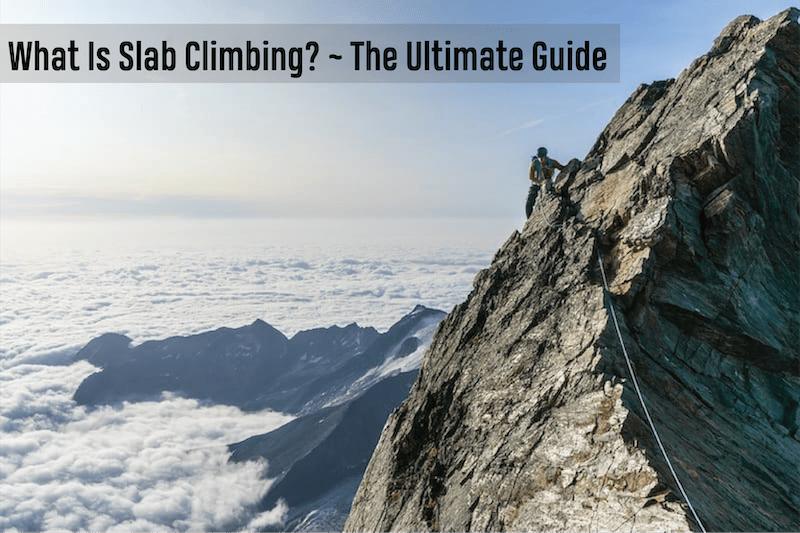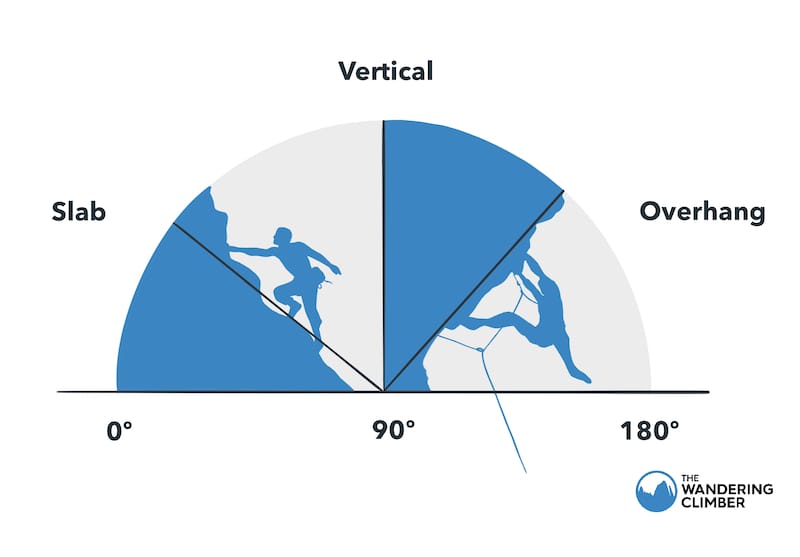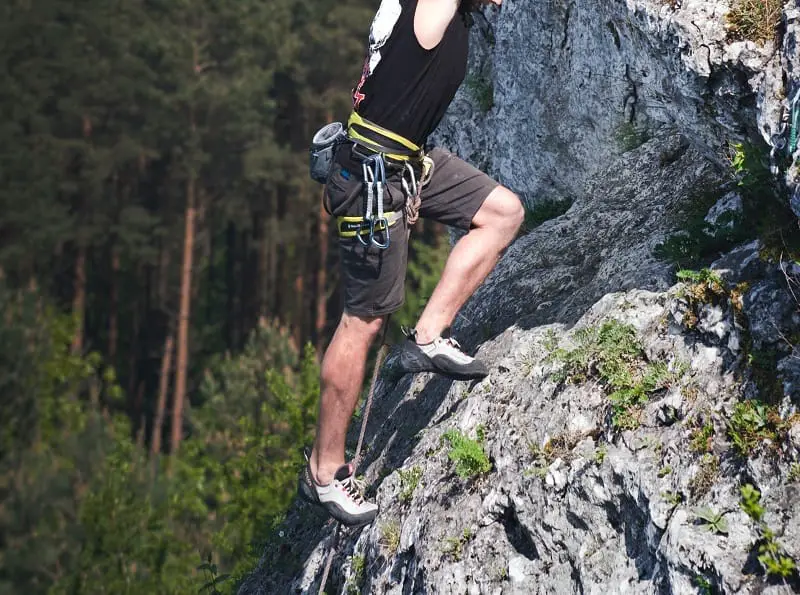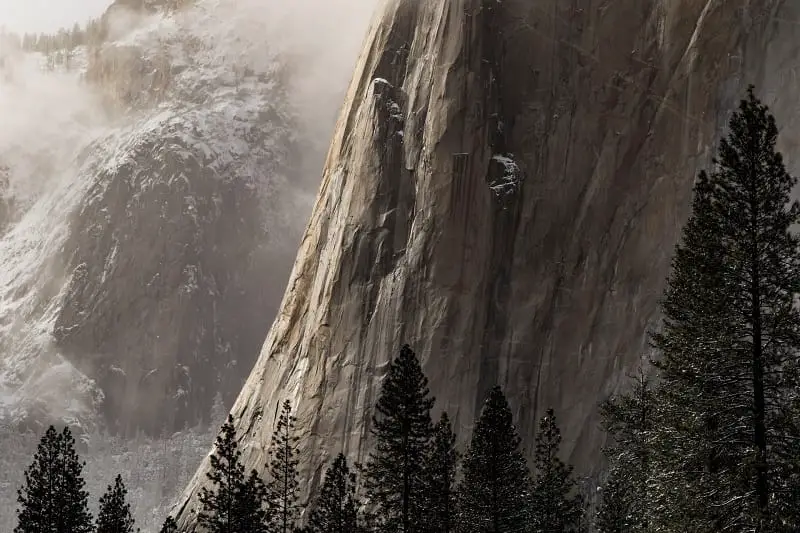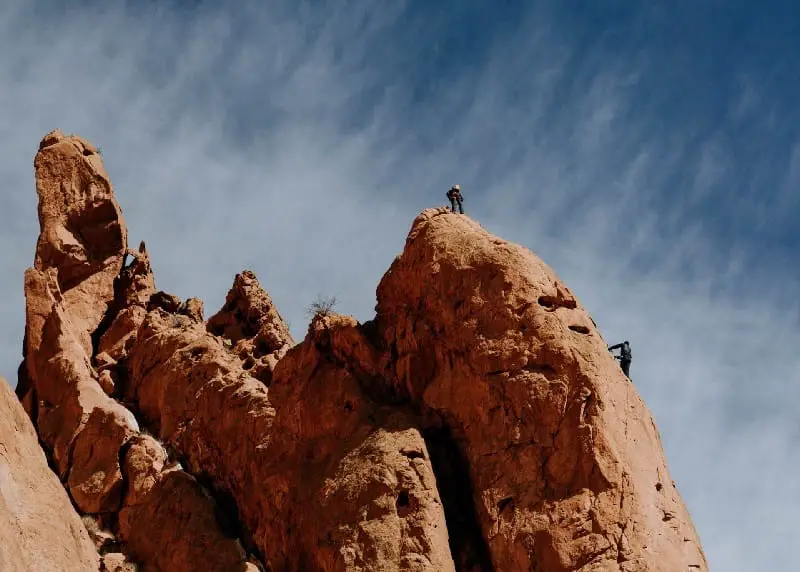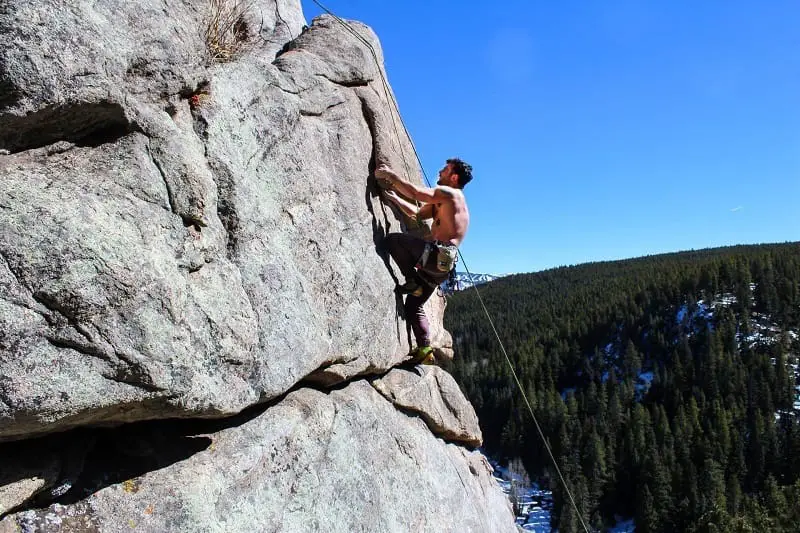Climbing up a wall that is less than vertical sounds easy, right?
Sorry to break it to you, but slab climbing is actually one of the most challenging climbing styles out there!
But don’t worry, in this article we will explain what slab climbing is, how you do it, how to fall while climbing on a slab and everything else you need to know to pack your bags and head to Yosemite, Squamish or any other top slab climbing area of the world. Why not even try Croatia, or the Devil’s Slide in the UK for a change?
Hey! By the way… this page contains affiliate links. So if you make a purchase after clicking one at no cost to you we may earn a small commission. Thanks for your support!
What Is Slab Climbing?
When slab climbing, you will be going up a rock face that has an angle of less than 90 degrees, so it is less steep than a vertical wall.
While this may sound easier, slab climbing is actually one of the hardest climbing styles out there. Like off-width climbing, it is quite a controversial style.
What is Slab Bouldering
Slab bouldering, like the name implies, is bouldering but on a less than vertical rock formation.
In contrast to traditional or sport climbing on a slab, you will have no protection or gear placed on this short route, and the only way is up!
Slab vs Face Climbing
In contrast to slab climbing, face climbing refers to routes on a vertical wall of about 90 degrees.
For both types of climbing, there is traditional as well as sports climbing. But in slab climbs, the bolts are usually few and far apart, and there aren’t many opportunities to place trad gear, as slabs are often characterized by their smooth profile and lack of pronounced holds or cracks.
The angle on a slab climb also makes it tougher to place trad gear.
Slab climbing is also called friction climbing because it relies heavily on using your feet and applying special foot techniques, like inside and outside edging and smearing.
Essentially, a slab climber uses the friction created from their weight and the rubber to climb.
Most climbing companies have their own specific slab climbing shoes specifically designed for the unique conditions required to slab climb!
What Is Smearing In Climbing
In rock climbing smearing is essentially a foot technique that uses the friction between the sole of your shoe and the rock or climbing wall. It allows you to essentially climb up a wall without using any specific foot holds. It is an extremely common technique while slab climbing.
Slab Climbing Tips
Here are some useful tips for those of you that want to get into slab climbing, and are unsure about where to start or how to train for it!
Slab Climbing Training
When you are climbing on a rock that has less than a 90-degree angle, strong biceps and hands won’t help you very much. You will need to rely a lot on your footwork!
That is what can make it so scary for beginners: slab climbing requires you to stand on a piece of smooth rock with no obvious hand- and footholds.
Having to rely so much on smearing and trusting the sticky rubber of your shoes might be weird at first, but with time you will get more confident and will improve your overall climbing technique too.
Balance/Body Position
When slab climbing, it is essential that you keep your balance and have the correct body position. You need to maintain your center of gravity above your feet so you can use friction and smearing to stay upright.
At the same time, you should not lean too far into the rock as this reduces the amount of rubber on the rock and can cause you to slide down.
It is best to keep your hips away from the rock and above your feet and use your hands and arms to find balance. This way, you also create maximum pressure on the ball of your foot and increase the friction of your shoes against the rock.
Try to keep moving to avoid getting (mentally and physically) stuck in a position you find hard to move on from.
So, keep your balance but don’t be static either. To achieve this, you will need body tension while keeping your muscles relaxed enough to balance.
Leg and Hip Mobility
For swift and fluid movements on slab routes, high steps will be essential for you.
Having good leg and hip mobility is super important for those moves, and it will help you advance at a good pace while keeping control over your movements.
Mobility means the combination of flexibility and strength, so don’t just focus on stretching your hips and legs but also use specific exercises to strengthen the muscles in this area like your hip flexors, for example.
If you’re into yoga, this is a good video combining yoga and exercises specifically targeting your hips.
Core and Calves
To maintain stability, you will also need a strong core! In fact, your feet and calves will do most of the heavy lifting on a slab climb, so don’t neglect those muscle groups when training.
Foot Technique
Slab climbing will make you a better climber because it forces you to focus on your technique, and you won’t be able to use your muscles to get out of a tricky move.
When slab climbing, there are often almost no foot- or handholds. So, you will be using specific foot techniques, like smearing and edging, to hold onto basically nothing.
This works because of the friction created between the sticky rubber of your climbing shoes and the rough surface of the rock.
But this requires weight: you need to confidently move and put your weight on your feet for them to stick to the rock. Keeping your heels low and your hips above your shoes, creates good conditions for smearing because you will maximize the contact surface between your climbing shoes and the rock, and also have maximum pressure on the balls of your feet to create friction.
Careful and precise foot placement are also essential for a successful slab climber.
Hands and Arms
What do you do with your arms and hands when there are no holds?
As we mentioned above, you will mostly rely on your feet to move upwards so your hands and arms will be busy balancing you while you step up.
If there is no handhold, you can press your hand that is not moving upwards, flat onto the wall with your fingers facing downward to create tension and make it easier to find and maintain balance.
If there are any available holds, make sure not to overgrip on tiny crimps and focus on pushing up with your legs instead, using the hold for balance.
Best Slab Climbing in the World
There are a lot of good spots for slab climbing out there, and here are some options if you are thinking about discovering a new climbing area near (or far) from you.
In the US, some of the best slab climbing locations can be found on the seemingly endless granite walls of the Yosemite Valley or in Joshua Tree in California.
Other top destinations for slabs are Moab in Utah and the Looking Glass Mountain in North Carolina.
If you are looking for somewhere outside of the US, Squamish in British Columbia is definitely a good choice for rock climbing in general, as well as some awesome slab climbs!
Heading over the big pond, Europe also offers some cool slab climbing locations.
A lot of them can be found in the UK (why not try Devil’s Slide or Satan’s Slip on the tiny island of Lundy?) or if you are looking for some more accessible and warmer areas, there are some good slab climbs around Split in Croatia as well.
How to Fall While Slab Climbing
The least helpful advice anyone can give is, “try not to fall.”
Well, thanks. But here are some tips to consider if you don’t manage to avoid a fall while leading on slab routes and don’t want to end up sliding down the rock face first.
Yes, try not to fall but if you do, make an effort to keep some form of control.
Depending on the angle of the slab and if there are any ledges, slab falls can be quite dangerous.
It is important that you remember to keep the rope in the correct position in relation to your feet and legs at all times while climbing to avoid getting flipped upside down in case of a fall.
This means that if you are above a protection, your rope should be going over your thigh in the direction of the last bolt or protection.
If your rope is running below your leg and in between your feet, it can cause you to flip in case of a fall, which makes it way more dangerous and harder to control your fall.
First, try to keep your face off the rock by using your hands and feet to kind of scramble downhill backwards which doesn’t sound easy and to be honest, it isn’t.
But it beats sliding down the slab on your stomach or back.
Try to keep your feet on the rock moving to reduce friction on the shoe rubber and lean forward so you can “pat down” the rock to avoid losing your balance and flipping backwards or sideways.
Keep your knees bent to absorb the impact and maintain your balance.
If this is not possible, another option is to slide down the rock with your feet onto the wall and your hand patting along for stability. This can cause quite a lot of damage to your climbing shoes as the rubber will take much of the friction, but it might be better than taking the friction with your skin.
However, remember to lean in and not outwards, assuming a kind of frog position to keep more control of your center of gravity.
Some people recommend turning around and running downhill, but I think that’s quite a feat considering you are probably out of balance and not able to do such controlled movements. But it might be possible on a smooth slab that has a low angle.
Good Slab Climbing Shoes
Because footwork is so essential to slab climbing, the right shoes are also crucial. Stiff and comfortable shoes work best on slabs, as you will be putting a lot of weight on your feet.
Stiff soles will support your feet and calves, and a flat sole also means more surface contact when smearing and edging, which is way more difficult with a downturned shoe, for example. The type of rubber on the shoe is also very important, as you want it to be as sticky as possible, while still being durable.
We wrote a whole article on the best slab climbing shoes out there, so here is a quick summary of two of the best slab climbing shoes!
For Beginners and/or Budget Conscious Climbers
The Black Diamond Momentum shoes are some of the best budget climbing shoes for slab climbing because they have an innovative rubber sole and flat shape, which is perfect for smearing.
They are synthetic and lined with hemp, so they will stay true to their original size over time (and they are also vegan).
They have a soft flex midsole, which makes them ideal for beginners who are just starting out to slab climb and might find stiffer and higher-performance shoes less comfortable.
For the Pros (see what I did here?)
There are not a lot of best-climbing-shoe-lists without this next model in them: La Sportiva TC Pro is a high-top shoe developed by granite master Tommy Caldwell, together with La Sportiva.
It features the company’s patented Vibram XS Edge rubber, ideal for smearing and edging on a slab. In addition, the shoe is quite stiff and supportive, and with its flat profile it is ideal for a slab!
And of course, if you happen to come across a crack on your slab, those shoes will serve you well in that scenario too!
Why Is Slab Climbing Hard?
We’ve covered this topic above when we talked about how to train for slab climbing. Slab climbing requires more technique than brute force.
So, it doesn’t matter if you can do 20 single-arm pull-ups. If your footwork is sloppy, you won’t get very far on a slab.
Falling on a slab is also a more dangerous affair than on an overhang where you’ll just swing it out, which adds to the style’s difficulty.
But overall, it is a beautiful and different climbing technique that will definitely help you improve in all other styles of climbing.

Alex is a computer scientist from Mexico currently studying a PhD on cancer genomics. He is a full-time researcher, a regular weekend warrior, and someone who enjoys sharing his thoughts through writing. He first started climbing at uni, where he fell in love with the beautiful places it took him. So, he promised himself he would someday experience the beauty of climbing and nature in every continent. Nowadays, after several years with this motivation in mind, school and work have taken Alex to 4 different continents already. This has given him the opportunity to make friends all over the world, experience different cultures and their communities, as well as the chance to listen all the stories these people have to share. Alex hopes these adventures will continue for many years, and is eager to share his experiences as a wandering climber.

